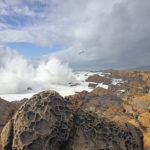This issue of Bay Nature rocks!
-150x150.jpg)
Sign up for our free weekly newsletter and understand everything better!

-150x150.jpg)
This issue of Bay Nature rocks!
-150x150.jpg)
Berkeley native Erik Vance first encountered the rocks of the East Bay hills as a teenager looking for excitement. For a century, geologists at UC Berkeley have used them to teach geologic mapping, in the process unraveling the complex geology of our hills. And for decades pioneering rock climbers learned techniques here that they took with them to the Sierra and beyond.

You’ll find some of Central California’s most remarkable rocks at this state park on the Sonoma coast. Waves, fault lines, and changes in sea level have left sublime stories written into the landscape.
-150x150.jpg)
Napa’s Palisades are rugged, beautiful, and about as wild as it gets in the Bay Area. And with the wildflowers in bloom, spring is high season for a great hike above the vineyards.
-150x150.jpg)
The high ridges and sandstone outcrops at Castle Rock have fascinated adventurers from explorer George Vancouver to the pioneers of modern rock climbing. Prolific wildflowers, great views, and an 80-foot waterfall add to the allure.

The quicksand won’t get you, but the quakes might.
-150x150.jpg)
It was 140 years ago, in October 1868, that the Hayward Fault unleashed the magnitude 6.8 temblor that put the fault on the map. The quake shook the entire region and virtually leveled the then-small hamlets of Hayward and San Leandro. Now, the land along the fault line is among the most densely populated in the region, a sobering situation given the likelihood of a repeat performance in the near future. But despite their destructive potential, the Hayward and the Bay Area’s other faults are the driving force behind our region’s varied and beautiful topography. Understanding how they work is key both to understanding our local landscapes and to preparing for the next Big One.
-150x150.jpg)
The peaceful hills of Black Diamond Mines Regional Preserve weren’t always so: One hundred twenty years ago, you’d have found bustling towns full of miners and their families and, nearby, the mine works and railroads that carried out tons of coal and sand, feeding the booming industries of Northern California. Today, the park offers grand vistas, abundant wildflowers, and a mine tour that gives an illuminating view of both the work of the miners and the geological history that brought them here and shaped the aboveground landscape.
-150x150.jpg)
At the mouth of Tomales Bay, sand dunes and seasonal wetlands coexist uneasily with California’s largest coastal campground. The dunes at Lawson’s Landing, home to rare butterflies and plants like the dune tansy, are among the few left of a once-common coastal habitat that could be restored and maintained as a healthy, functioning ecosystem. But can that be accomplished without driving out the family-run camping operation at the dunes that, since 1957, has been an affordable summer getaway for thousands of visitors?
-150x150.jpg)
Discover rare rocks, distant stars, beautiful wildflowers, and a bit of California history all at one small state park south of San Juan Bautista.